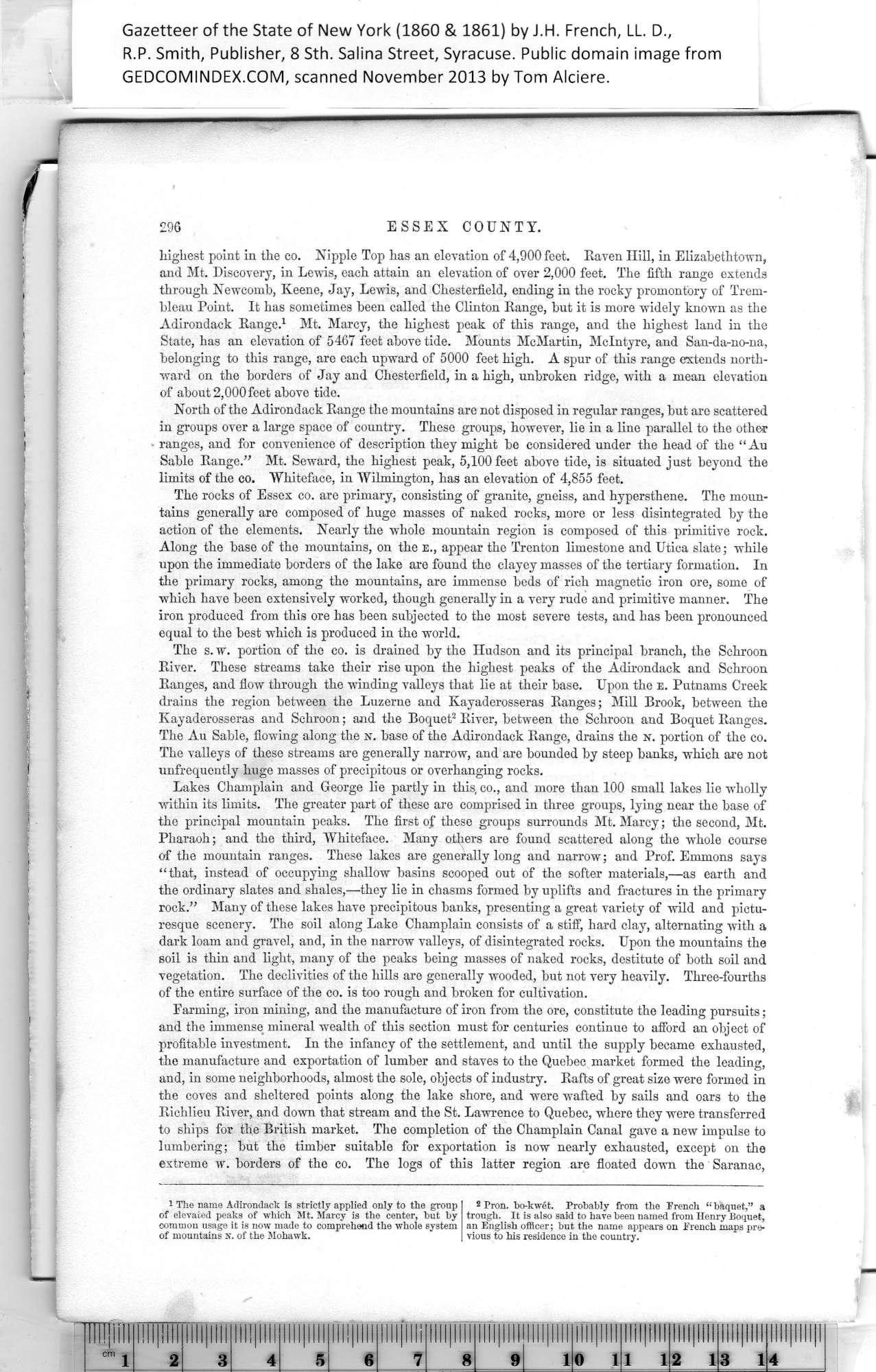|
296 ESSEX COUNTY.
highest point in the co. Nipple Top has an elevation of 4,900 feet. Raven Hill, in Elizabethtown,
and Mt. Discovery, in Lewis, each attain an elevation of over 2,000 feet. The fifth range extends
through Newcomb, Keene, Jay, Lewis, and Chesterfield, ending in the rocky promontory of Trem-
bleau Point. It has sometimes been called the Clinton Range, but it is more widely known as the
Adirondack Range.1 Mt. Marcy, the highest peak of this range, and the highest land in the
State, has an elevation of 5467 feet above tide. Mounts McMartin, McIntyre, and San-da-no-na,
belonging to this range, are each upward of 5000 feet high. A spur of this range extends north¬
ward on the borders of Jay and Chesterfield, in a high, unbroken ridge, with a mean elevation
of about 2,000 feet above tide.
North of the Adirondack Range the mountains are not disposed in regular ranges, but are scattered
in groups over a large space of country. These groups, however, lie in a line parallel to the other
ranges, and for convenience of description they might be considered under the head of the “ Au
Sable Range.” Mt. Seward, the highest peak, 5,100 feet above tide, is situated just beyond the
limits of the co. Whiteface, in Wilmington, has an elevation of 4,855 feet.
The rocks of Essex co. are primary, consisting of granite, gneiss, and hypersthene. The moun¬
tains generally are composed of huge masses of naked rocks, more or less disintegrated by the
action of the elements. Nearly the whole mountain region is composed of this primitive rock.
Along the base of the mountains, on the e., appear the Trenton limestone and Utica slate; while
upon the immediate borders of the lake are found the clayey masses of the tertiary formation. In
the primary rocks, among the mountains, are immense beds of rich magnetic iron ore, some of
which have been extensively worked, though generally in a very rude and primitive manner. The
iron produced from this ore has been subjected to the most severe tests, and has been pronounced
equal to the best which is produced in the world.
The s. w. portion of the co. is drained by the Hudson and its principal branch, the Schroon
River. These streams take their rise upon the highest peaks of the Adirondack and Schroon
Ranges, and flow through the winding valleys that lie at their base. Upon the E. Putnams Creek
drains the region between the Luzerne and Kayaderosseras Ranges; Mill Brook, between the
Kayaderosseras and Schroon; and the Boquet2 River, between the Schroon and Boquet Ranges.
The Au Sable, flowing along the n. base of the Adirondack Range, drains the n. portion of the co.
The valleys of these streams are generally narrow, and are bounded by steep banks, which are not
unfrequently huge masses of precipitous or overhanging rocks.
Lakes Champlain and George lie partly in this, co., and more than 100 small lakes lie wholly
within its limits. The greater part of these are comprised in three groups, lying near the base of
the principal mountain peaks. The first of these groups surrounds Mt. Marcy; the second, Mt.
Pharaoh; and the third, Whiteface. Many others are found scattered along the whole course
of the mountain ranges. These lakes are generally long and narrow; and Prof. Emmons says
“that, instead of occupying shallow basins scooped out of the softer materials,—as earth and
the ordinary slates and shales,—they lie in chasms formed by uplifts and fractures in the primary
rock.” Many of these lakes have precipitous banks, presenting a great variety of wild and pictu¬
resque scenery. The soil along Lake Champlain consists of a stiff, hard clay, alternating with a
dark loam and gravel, and, in the narrow valleys, of disintegrated rocks. Upon the mountains the
soil is thin and light, many of the peaks being masses of naked rocks, destitute of both soil and
vegetation. The declivities of the hills are generally wooded, but not very heavily. Three-fourths
of the entire surface of the co. is too rough and broken for cultivation.
Farming, iron mining, and the manufacture of iron from the ore, constitute the leading pursuits;
and the immense mineral wealth of this section must for centuries continue to afford an object of
profitable investment. In the infancy of the settlement, and until the supply became exhausted,
the manufacture and exportation of lumber and staves to the Quebec market formed the leading,
and, in some neighborhoods, almost the sole, objects of industry. Rafts of great size were formed in
I the coves and sheltered points along the lake shore, and were wafted by sails and oars to the
Richlieu River, and down that stream and the St. Lawrence to Quebec, where they were transferred
to ships for the British market. The completion of the Champlain Canal gave a new impulse to
lumbering; but the timber suitable for exportation is now nearly exhausted, except on the
extreme w. borders of the co. The logs of this latter region are floated down the Saranac,
|
2 I’ron. bo-kwet. Probably from the French “ baquet,” a
trough. It is also said to have been named from Henry Boquet,
an English officer; but the name appears on French maps pre¬
vious to his residence in the country. |
1
The name Adirondack is strictly applied only to the group
of elevated peaks of which Mt. Marcy is the center, hut hy
common usage it is now made to comprehend the whole system
of mountains n. of the Mohawk.
|
